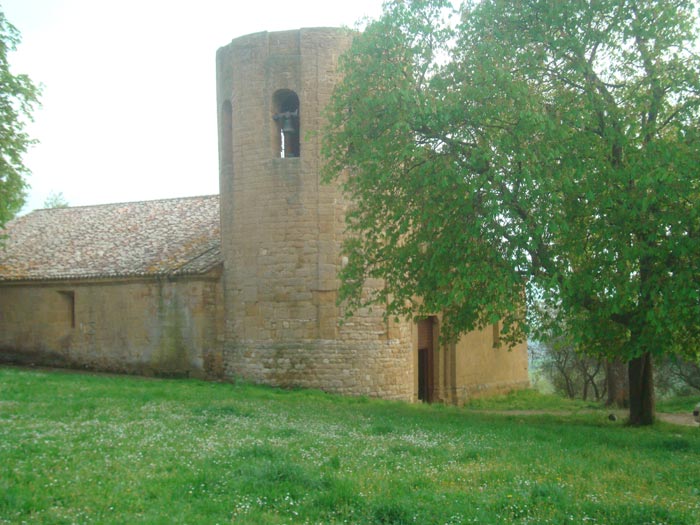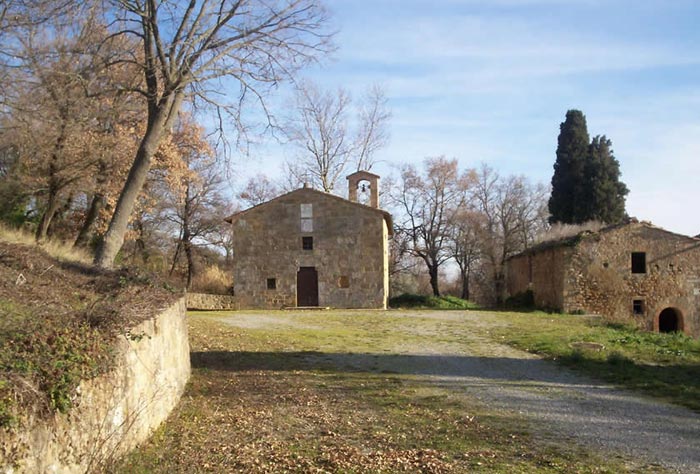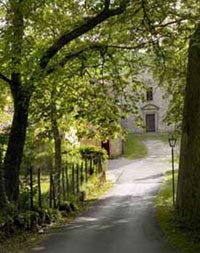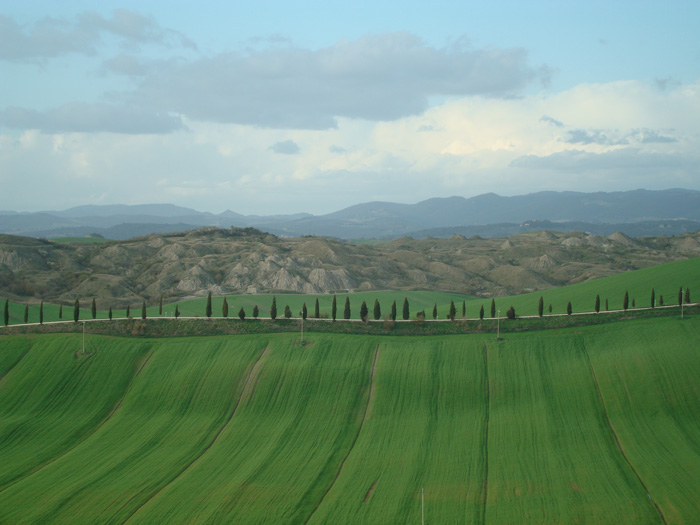Tuscan Mediaeval Parish Churches (Pievi) |
Monticchiello, La Foce and San Quirico d'Orcia are situated within an hour's drive from Podere Santa Pia. The road which leads from Castiglioncello Bandini to Monticchiello and San Quirico, passing first through Castello Porrona, Montalcino and Pienza, is breathtaking. The scenery of the Val d’Orcia begins with a symmetry of natural harmony with its rolling hills, and then changes into the majestic grandeur of the Amiata. |
|||
 |
|||
| Pieve dei Santi Vito e Modesto a Corsignano in Pienza |
|||
| The word pieve comes from the Latin plebs meaning population and was the parish church at the head of a series of minor churches (suffragan churches) situated in the same district. The parish church represented the territory under its jurisdiction and was responsible for carrying out tasks of religious and civic character (for example by making sure that the roads were kept in good repair). The largest number of parish churches date back to the period between the 9 C and the 13 C. Some however date back even earlier (like the parish church of Pacina, which was probably built in the 7 C, if not earlier). The parish church was the only church that was allowed to contain a baptismal font and possess a cemetery and thus it became the centre of the life for its parishioners. These churches were originally founded to encourage the spread of the Christian doctrine in the country districts and provide for the spiritual and material needs of worshippers living a long way away from the parishes in the city. They were subject to the authority of the Bishop. The parish church's importance as an institution fell into disuse at the beginning of the late Middle Ages, when many rural town councils were created and this later led to changes in the division of the territory. The churches grew up along the main roads, close to already existing villages, and gradually took on the task of offering refuge and refreshment for pilgrims and travellers. The bell tower was a fundamental element; not only could the parishioners use it to give warning of imminent danger, it also attracted the attention of the faithful on feast days or for religious celebrations. These parish churches were always very austere and simple in aspect; they were illuminated by small windows and sometimes decorated with grotesque figures. These elements were an invitation to prayer and tended to give the faithful a fear of God and his punishment. |
|||
 |
|||
| Pieve di Santa Maria dello Spino |
|||
| The Pieve di Santa Maria dello Spino, between Monticchiello and Bagno Vignoni, is used on the annual Corpus Domini procession, the Processione del Corpus Domini. It already existed in 1050 and the place was a stoppimg post (mansium ad sextum) on the imperial road that connected the Cassia consular road with the Aurelia. The facade is constructed with sandstone blocks and a few disorganized friezes, pieces that had been recovered from a former structure; the roof has a double slope. The bass relief of a dragon and a human figure with an animal on a leash is divided by the only window. A light frame with an intertwining vegetable theme forms, with the roof, a kind of gable. There was probably in the past a roof over the front entrance of which you can see the remains. The bell tower was built before the actual church and was included during the enlargement in medieval times. On the right hand side the "scarpa" base is to be noticed because it is surmounted by a meridian, the elegance of the hanging arches and the good conservation of the mullioned window. You reach the courtyard through the arch. On the right hand wall you can see the slits and the arquebusiers, which show that the complex was fortified. To the left are the remains of a cloister brought to light in 1950. The elegant palace with the typically Sienese mullioned windows was the summer home for bishops. Below the courtyard floor precious mosaics have been discovered that date back to the Roman Empire and which belonged to a large Roman villa furnished with hot air heating. Judging from the size of the "greca" design that is the frame of the floor, we can imagine that the mosaics proceed under the level of the floor of the church for quite an area. The entrance of the church is unusual: instead of going up the steps, you go down. The inside, divided in three naves, reminds us of late French Romanesque, quite near to Gothic. The first span to your right is smaller than the others because it includes the preexisting bell tower. The capitals are elegantly decorated with human figures and geometric forms. The beautiful vault of the strange "tiburio" has a barrel shape, while the lateral ones are "a vela". |
|||
|
|||
| Walking and trekking in Tuscany | Walking in the Val d'Orcia | |||
| Walking around Pienza The walk takes of at Piazza Dante Alighieri, through the Viale S. Caterina and going down along the Via delle Fonti, direction Pieve di Corsignano. |
 Vivo d'Orcia, Borgo dell'Eremo and Chiesa di San Marcello |
||
| From Montepulciano to Pienza | 11 km, 3 hours A gentle up & downhill walk from the magnificent town Montepulciano to the perfect place Pienza along the beautiful scenery of Toscany. The walk starts at the Piazza Grande, next to the Duomo. |
|||
| Walking in Tuscany | Walking in the Val d'Orcia Vivo d'Orcia - Vivo d'Orcia Castelnuovo dell'Abate - Vivo d'Orcia From San Quirico d'Orcia to Bagno Vignoni Bagno Vignoni - La Foce Bagno Vignoni - Bagno Vignoni Castiglione d'Orcia - Castiglione d'Orcia |
|||
Tuscan farmhouses | Podere Santa Pia |
||||



